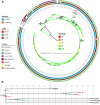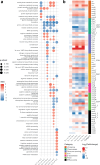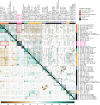In-host evolution of Yersinia enterocolitica during a chronic human infection
- PMID: 40595576
- PMCID: PMC12218051
- DOI: 10.1038/s41467-025-60782-6
In-host evolution of Yersinia enterocolitica during a chronic human infection
Abstract
Bacteria exhibit remarkable adaptability in response to selective pressures encountered during infection and antibiotic treatment. We characterize four Yersinia enterocolitica clonal isolates from successive bacteremia episodes that evolved within an elderly patient over 14 years. Their common evolution is characterized by a genome size reduction resulting in the loss of about a hundred genes and a so far undescribed deletion in the DNA gyrase gene gyrA conferring quinolone resistance. Third-generation cephalosporin resistance of the last isolate correlates with a truncation of OmpF in synergy with an increased production of BlaA and AmpC β-lactamases. A strong proteome remodeling of the isolates reveals a perturbed stringent response, as well as impaired metabolism which substantiate their severe growth defects in vitro, accounting for antibiotics tolerance and possibly therapeutic failure. This study documents previously unreported genetic and phenotypic changes associated with in-host adaptation of a pathogenic Yersinia species under antibiotic pressure.
© 2025. The Author(s).
Conflict of interest statement
Competing interests: The authors declare no competing interests. Inclusion & Ethics Statement: All collaborators of this study have fulfilled the criteria for authorship required by Nature Portfolio journals. Roles and responsibilities were agreed among collaborators ahead of the research. This research was not severely restricted or prohibited in the setting of the researchers, and does not result in stigmatization, incrimination, discrimination, or personal risk to participants. The ethical committee of the University Hospital of Tours was informed about the study. The study is registered under the number 2025-032.
Figures






Similar articles
-
Clinical outcomes of phenotype-guided treatment in group D carbapenemase-producing Enterobacterales bacteremia.Microbiol Spectr. 2025 Jul;13(7):e0027325. doi: 10.1128/spectrum.00273-25. Epub 2025 May 27. Microbiol Spectr. 2025. PMID: 40422283 Free PMC article.
-
Genomic description of Microbacterium mcarthurae sp. nov., a bacterium collected from the International Space Station that exhibits unique antimicrobial-resistant and virulent phenotype.mSystems. 2025 Jun 17;10(6):e0053725. doi: 10.1128/msystems.00537-25. Epub 2025 May 20. mSystems. 2025. PMID: 40391897 Free PMC article.
-
Prevalence and genomic insights into Yersinia enterocolitica in Southeastern China (2008-2022).Appl Microbiol Biotechnol. 2025 Jul 7;109(1):161. doi: 10.1007/s00253-025-13500-7. Appl Microbiol Biotechnol. 2025. PMID: 40622594 Free PMC article.
-
Biomarkers as point-of-care tests to guide prescription of antibiotics in people with acute respiratory infections in primary care.Cochrane Database Syst Rev. 2022 Oct 17;10(10):CD010130. doi: 10.1002/14651858.CD010130.pub3. Cochrane Database Syst Rev. 2022. PMID: 36250577 Free PMC article.
-
Prophylactic antibiotics for adults with chronic obstructive pulmonary disease: a network meta-analysis.Cochrane Database Syst Rev. 2021 Jan 15;1(1):CD013198. doi: 10.1002/14651858.CD013198.pub2. Cochrane Database Syst Rev. 2021. PMID: 33448349 Free PMC article.
References
-
- Dekker, J. P. Within-host evolution of bacterial pathogens in acute and chronic infection. Annu Rev. Pathol.19, 203–226 (2024). - PubMed
-
- Shepherd, M. J. et al. Ecological and evolutionary mechanisms driving within-patient emergence of antimicrobial resistance. Nat. Rev. Microbiol22, 650–665 (2024). - PubMed
-
- Levin-Reisman, I. et al. Antibiotic tolerance facilitates the evolution of resistance. Science355, 826–830 (2017). - PubMed
MeSH terms
Substances
Grants and funding
LinkOut - more resources
Full Text Sources

